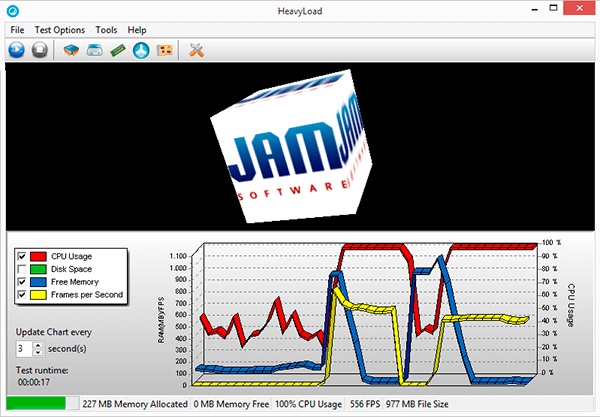How to Stress-Test CPUs and PCs (Like We Do)
CPU Only: powerMAX With AVX Or SSE & Heavy Load
CPUID powerMAX
This combined CPU and GPU stress test wasn’t our first choice when it came to evaluating graphics cards. However, it does do a better job loading down CPUs. Being able to switch easily between AVX and SSE code paths is also a definite plus. Download powerMAX here.
powerMAX With AVX
powerMAX tops out a bit below Prime95 with AVX, but it nearly matches the popular stress test's results. The loads powerMAX generates are well above average, making it a suitable tool for testing CPU coolers.
Conversely, you won't want to use it for stability-testing overclocked PCs operating close to their limits unless the goal is to identify temperature issues.
| Header Cell - Column 0 | CPU Package(PECI) | Core Average | SensorSocket | Memory | CPU (Watts) | System (Watts) |
|---|---|---|---|---|---|---|
| Measurement | 79°C | 79°C | 98°C | 28°C | 160W | 232W |
| Compared to Maximum | 90.8% | 91.9% | 93.3% | 77.8% | 93.0% | 92.1% |
| Assessment | High package temperatureVery high socket temperatureSomewhat low memory temperatureVery high CPU and system power consumption | |||||
| Use for | Cooling test for high-performance coolers |
powerMAX With SSE
On our test platform, utilizing the SSE code path resulted in temperatures that averaged ~10°C lower than before. System RAM was the exception; it actually heated up more than when we sent AVX instructions down the CPU's execution pipeline.
| Header Cell - Column 0 | CPU Package(PECI) | Core Average | SensorSocket | Memory | CPU (Watts) | System (Watts) |
|---|---|---|---|---|---|---|
| Measurement | 69°C | 68°C | 98°C | 30°C | 132W | 191W |
| Compared to Maximum | 79.3% | 79.1% | 93.3% | 83.3% | 76.7% | 75.8% |
| Assessment | Medium package temperatureModerate memory temperatureMedium CPU and system power consumption | |||||
| Use for | Stability test for overclocked systems |
Heavy Load
Heavy Load works if you're trying to generate a realistic CPU load, and by realistic we mean the types of loads you'd encounter in a game applying average demands to your components. Running Heavy Load won’t tell you anything about your CPU cooler's limits. But it is a decent indicator of how a CPU might fare during everyday operation. It’s also safe to use on older or mobile hardware without worrying about breaking anything. In that sense, it's not really a conventional stress test. Download Heavy Load here.
What the CPU test actually does remains a developer secret. It doesn't seem to explicitly use modern instruction set extensions, though.
| Header Cell - Column 0 | CPU Package(PECI) | Core Average | SensorSocket | Memory | CPU (Watts) | System (Watts) |
|---|---|---|---|---|---|---|
| Measurement | 58°C | 61°C | 60°C | 30°C | 105W | 156W |
| Compared to Maximum | 66.7% | 70.9% | 57.1% | 83.3% | 61.0% | 61.9% |
| Assessment | Low core and package temperatureModerate memory temperatureSomewhat low CPU and system power consumption | |||||
| Use for | Stability test for low-end and older hardwareStability test for low-end mobile devicesSimulation of average everyday loads |
MORE: Best CPUs For Gaming
Get Tom's Hardware's best news and in-depth reviews, straight to your inbox.
MORE: Intel and AMD Processor Benchmark Hierarchy Comparisons
MORE: All CPUs Content
Current page: CPU Only: powerMAX With AVX Or SSE & Heavy Load
Prev Page CPU Only: AIDA64 With CPU, FPU, Cache, Or Memory Next Page CPU Only: Measuring Power Consumption With Different Stress Tests
Igor Wallossek wrote a wide variety of hardware articles for Tom's Hardware, with a strong focus on technical analysis and in-depth reviews. His contributions have spanned a broad spectrum of PC components, including GPUs, CPUs, workstations, and PC builds. His insightful articles provide readers with detailed knowledge to make informed decisions in the ever-evolving tech landscape
-
WINTERLORD Is this like a fancy water cooler im guessing? what about a typical AIO cooler. In fact i have a skyth fuma but may save up to get some kind of AIO water cooling been tryin to find decent reviews on decent water coolers both cheap and if needed high end. not no alpha cooler though lolReply
Alphacool Eisblock XPX ($73.99 On Newegg)
Alphacool Eiszeit 2000 Chiller -
FormatC This is a high-end compressor cooler for up to 1500 watts heat input. It's a modified version from industry and mostly used to cool the head of powerful laser cutters. Why I'm using this one? To show, which program is able to do it right. If you have additionally limitations from coolers, thermal throttling and other funny things, you will never see the exact difference. I can keep a constant water temperature of 20°C to make all the test results comparable. ;)Reply -
Th_Redman What did you guys put on the hotdog after testing? A little mustard, ketchup, relish, sauerkraut...? LOL.Reply -
aquielisunari I use Aida, Prime 26.6, Superposition, UserBenchmark, MSI's kombustor and I no longer use Heaven. I may be forgetting a couple. But something has always felt a little off. I finally see what it was. My build was missing a hotdog and its bun. I always do love learning from the pros. I placed it on a piece of parchment and instantly I notice a difference.Reply
I routinely check temperatures, loads and other info from my system. I also stress test with different CPU and GPU benchmark/stress test software. Thanks for the info. Page bookmarked. -
CompuTronix As the author of the Intel Temperature Guide - http://www.tomshardware.com/forum/id-1800828/intel-temperature-guide.html - I can fully appreciate how much work went into creating this outstanding article, which has been sorely needed!Reply
Since most users test their rigs without a sense of scale for power and temperature, they can't compare apples to apples, especially when combined with major variables such as differences in ambient temperature, hardware configurations and software utilities. This article provides a perspective and some excellent comparisons.
The Intel Temperature Guide differs in its approach toward the topic of processor Core temperatures and cooling with respect to Intel's TDP specifications, and distinguishes between steady workloads for thermal testing versus fluctuating workloads for stability testing. Nevertheless, our results are very similar.
However, since Intel validates their thermal specifications at a steady 100% TDP, it's most appropriate to select utilities that don't overload or underload the CPU. The only utilities I've ever found that come as close as possible to 100% TDP are Prime95 v26.6 Small FFT's as a steady workload for thermal testing, and Asus RealBench as a fluctuating workload for stability testing.
Although the topic of Prime95 (with and without AVX) was covered, I would like to have seen RealBench included in your test suite,since it's widely accepted as an excellent utility for testing overall system stability, and uses a realistic AVX workload.
Otherwise, great work! I was very pleased to read this article!
CT :sol: -
cangelini Reply20741319 said:As the author of the Intel Temperature Guide - http://www.tomshardware.com/forum/id-1800828/intel-temperature-guide.html - I can fully appreciate how much work went into creating this outstanding article, which has been sorely needed!
Since most users test their rigs without a sense of scale for power and temperature, they can't compare apples to apples, especially when combined with major variables such as differences in ambient temperature, hardware configurations and software utilities. This article provides some excellent comparisons.
The Intel Temperature Guide differs in its approach toward the topic of processor Core temperatures and cooling with respect to Intel's TDP specifications, and distinguishes between steady workloads for thermal testing versus fluctuating workloads for stability testing. Nevertheless, our results are very similar.
However, since Intel validates their thermal specifications at a steady 100% TDP, it's most appropriate to select utilities that don't overload or underload the CPU. The only utilities I've ever found that come as close as possible to 100% TDP are Prime95 v26.6 Small FFT's for thermal testing, which is a steady workload, and Asus RealBench for stability testing, which is a fluctuating workload.
Although the topic of Prime95 (with and without AVX) was covered, I would like to have seen RealBench included in your test suite, as it's widely accepted as an excellent utility for testing overall system stability, and uses a realistic AVX workload.
Otherwise, great work! I was very pleased to read this article!
CT :sol:
That's an awesome resource, CT! -
WyomingKnott Reply20740696 said:What did you guys put on the hotdog after testing? A little mustard, ketchup, relish, sauerkraut...? LOL.
Thermal compound. Why not? People have used condiments between their CPUs and their coolers. -
FormatC Step 1 - Collect all what I need:Reply
Step 2 - Start the oven
Step 3 - Enjoy!
The benchmark:
The complete review was so funny, but it was never translated :(

